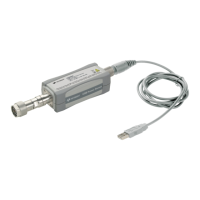Making Measurements 2
U2000 Series Operating and Service Guide 27
INTernal and EXTernal Zeroing
Zeroing a power sensor is performed in order to reduce zero measurement
offset and noise impact to improve the accuracy of RF power measurement.
The U2000 Series USB power sensors have two types of zeroing; INTernal
zeroing and EXTernal zeroing.
INTernal zeroing is a new type of zeroing process whereby RF/Microwave
power can be left connected to the sensor while it is being zeroed. High
isolation switches are opened in the sensor to isolate the diode sensor from
the electronic circuitry. With the available processing power from the
Embedded DSP in the product, the INTernal zeroing algorithm is applied to
the internal zeroing data. Hence, INTernal zeroing provides the convenience of
performing a zero with the RF/microwave signal present. This feature makes
INTernal zeroing more convenient, but one may only use INTernal zeroing if
zero set (INTernal) is within the user's application requirements.
EXTernal zeroing process is a two- step process. The RF/Microwave signal to
be measured must be removed from the product and then the product can be
zeroed. Do not apply any RF/microwave signals to the RF input port during
EXTernal zeroing processes. Any RF/microwave signals pick- up by the diode
sensor during EXTernal zeroing will be considered as part of the noise.
EXTernal zeroing generally has better zero set performance. The INT or EXT
zeroing selection should be made based on the measurement needs.
Users can choose to use either INTernal zeroing or EXTernal zeroing. The
sensor is defaulted with INTernal zero every time it is power up.
Figure 2- 2
shows the illustration on how to set the EXTernal zeroing if the N1918A Power
Panel tool is used.

